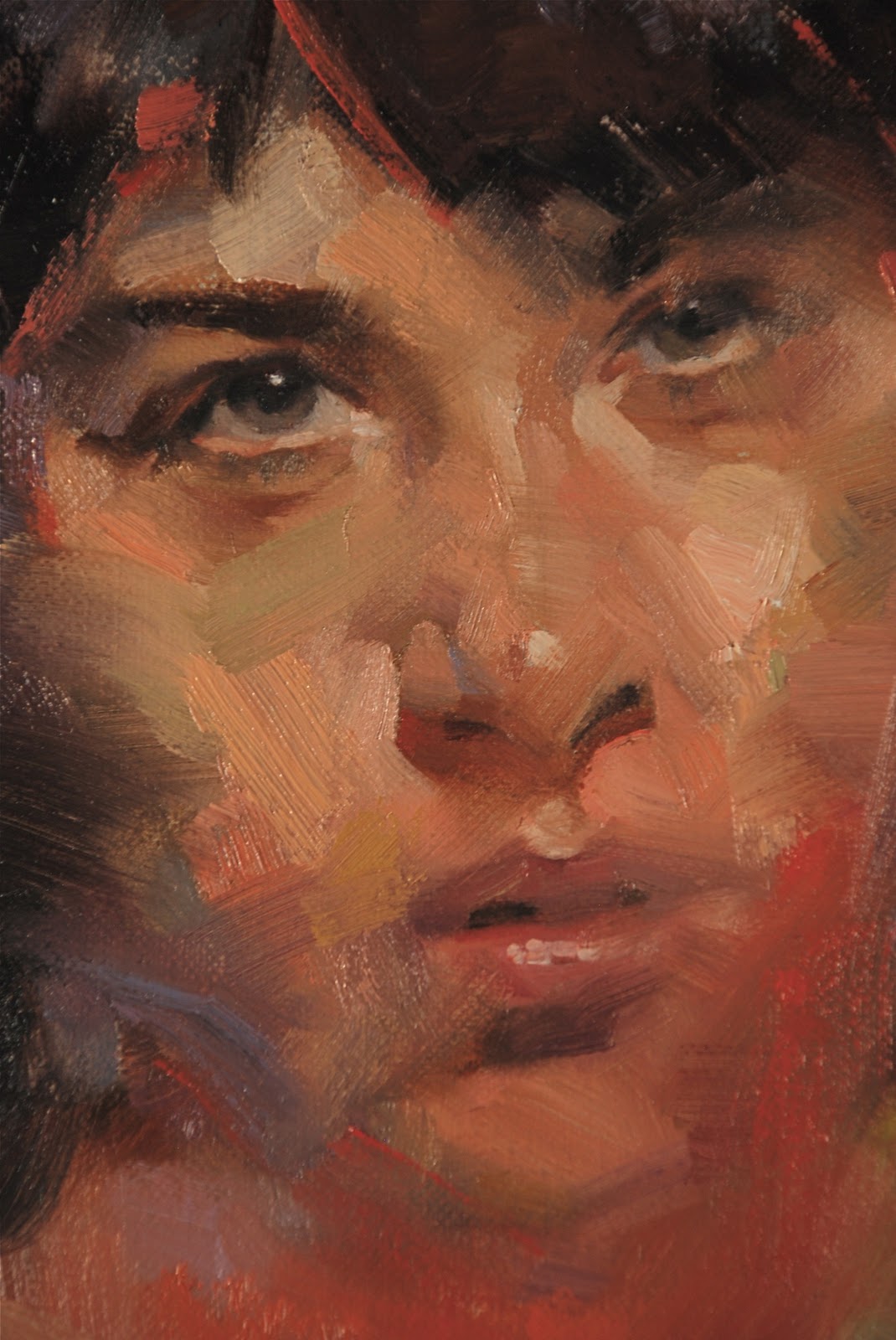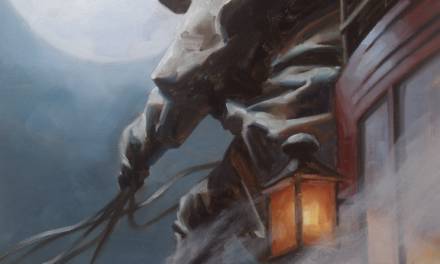Gregory Manchess
The principles of physics, as far as I can see, do not speak against the possibility of maneuvering things atom by atom.
–Richard Feynman, Nobel Laureate
It’s entirely important for us to paint with our minds focused on today, as in-tune with our generation as possible, not ‘ahead of our time’ as the favorite saying goes.
The intelligent painter reasons that it would be a good thing for their work to look as fresh in the future as when they first laid down the brush from finishing it. The thought of our work being lost to the elements, or battered by time, turned to dust by mold, moisture, and neglect, is at best depressing, at worst, revolting. We want to leave our marks, and we want them to last. We spend a considerable amount of time studying, designing, developing, and practicing to make substrates indestructible, our paint long-lasting, cracks being the bane of a beautiful surface.
The field is full of art restorers, museum professionals, and smart, creative artists, as well as scientists, who have worked out excellent methods for elongating the rather tenuous life-times of our paintings. They make strides everyday to preserve our best efforts.
For example, there is a rather costly technique that can actually restore the rotten canvas backing from an old oil painting. The piece is laid face down on a platen pierced with tiny holes through which air is pulled. This vacuum securely holds the painting to the platen while a chemical is applied to the canvas back, loosening it from the painting. A new canvas is glued to the back of the old painting’s substrate. Amazing.
There will be more techniques coming for restoring artwork. Michio Kaku’s latest book, The Physics of the Future, is stunning for its cataloging of scientific advances over the next 100 years. Interviewing scientists on today’s cutting edge of breakthroughs, Kaku combined a boatload of the latest information with the latest speculation to give a glimpse of what’s in store for us. Especially miniaturization.
From the somewhat familiar world of nanotechnology comes the field of programmable matter. Scientists at Intel visualize matter that can change it’s shape, color, texture. (Think T-1000 from The Terminator.) Currently called ‘catoms’, they are basically computer chips in the shape of a grain of sand, manipulated by electrical charges that cause them to line-up in designated patterns.
This is entirely my own speculation, but with the miniaturization of techniques, no painter will ever worry again about paint cracking. It will simply be unnecessary as nanotechnology will allow paint to be rebuilt into these flaws. Duplicated color will be grown directly into the cracks, re-filling them from the substrate to the surface. But that’s for the old paintings we’re familiar with.
What’s even more advanced, and I dare predict this may happen perhaps before mid-century, is the redevelopment of pigment itself. Smart Pigment will be built of such small intelligent materials that it will not be made of ground substances, but myriads of microscopic pigment-techs made of molecular machines known as nanoparticles. We will not paint with toxic materials any longer. We’ll paint with artificial pigment that looks, acts, and applies like the old pigments, but it will have what we cannot possibly have at this point.
This paint will have memory.
We’ll be able to paint with this material as before, but we’ll also be able to back up, change, rearrange, reprogram, re-dictate, and re-watch our actual painting steps. We’ll be able to change color, change texture, change value, change thickness–on the fly. When we’re done, we’ll be able to take the same painting and apply it, much like an auto-print, to another surface, at any size, on nearly any surface. (…and there’s no drying time…)
We’ll be able to take that same picture, or expression, and hand the sequence to a friend or client to allow them to have an exact copy made from scratch, stroke for stroke, from the surface up. And they’ll be able to watch it paint itself if they wish, over and over. The day when paintings are truly unfinished will have most definitely arrived.
This, of course, leads to questions about authenticity, and copyright protection. It will have to be developed as we go, as we’ve always gone, a little at a time.
Why is this question important to us today? Because it frees us, as living artists, once again, to focus on the creation, and not the attention. It’s far more important for an artist to concentrate on developing good visual images than to waste time figuring out how future generations will adore it, or us. If no one cares in the first place, your stalwart, indestructible artwork will just as likely be more of a nuisance.
Paint now. Wonder about the other stuff later.








I quite often work on an iPad, and at least three times now whilst painting with acrylics or oils on the easel, I've caught myself reaching for the bottom right of the canvas to press “Undo”. You're right, Greg – at some point in the near future, that might not feel so silly…
These ideas about the paint of the future – every single one you described – are already fullfilled completely in digital painting. We don't have to wait for “nano-paint” to change the landscape of painting. We just have to turn our attention away from canvas and paper (what a crude way to paint anyway in the year 2012!) towards the screens and projectors to see that these bold visions about the future of painting have already arrived. Give it yet another 5 to 10 years and the digital paint – driven by fluid and particle simulation – will just feel like the real deal.
What a great post Greg. It makes me think of tattooing. Usually a tattoo done 25 years ago by now has lost it's luster due to pigments fading from sun exposure, aging, etc. I can only imagine what a tattoo would look like done with NanoInk, it would be incredible!
Yep, we already have digital, Daniel, I see what you are saying. Anyone who goes to a “show” of digital art today is disappointed because it's only a show of flat prints. The viewer is exactly the same distance from the electronic media as the monitor, which is completely untouchable, unattainable.
The key factor in being in the presence of reality, in the presence of an actually painting, is made more appealing to the mind because of having to resist the urge to touch it. Physical paint will likely never lose it's appeal this way, just as the caverns at Lascaux have not. They are the very reality of ancient human hands on stone.
Virtual reality is getting closer and closer to feeling like reality, but not actually achieving it. Check out Kaku's book for some very interesting aspects about that. The entire 'uncanny valley' idea gets play here. Years ago, I wrote down how printers at some point, will be able to print out dimensional paints to mimic the strokes of the painter's actual piece.
It's coming. 3D printers are close to it now.
I work in the museum exhibit design industry as an illustrator, muralist, and graphic designer. We recently purchased a CNC machine that will actually sculpt objects created in digital sculpting programs like Zbrush. It's amazing to see how much detail it can achieve, but it's still not even close to what a skilled sculptor can do with his/her hands. Now that isn't to say that day isn't coming, but when it does, I don't see how traditional artists working in commercial fields will be able to continue working without adapting. I believe that traditional mediums will exist exclusively in fine art galleries as time passes. When I was in college, I was a full-blooded traditional painter, and objected to anything “digital.” I was even so naive as to say that digital work shouldn't even be considered. Now, as a commercial artist dealing with fickle clients, I don't see how I used to get anything done before I started painting in photoshop. With that said, I feel that there seems to be a growing “us against them” attitude between digital and traditional painters. Some even make openly hostile remarks without even realizing it. When I learned that photoshop doesn't actually create the painting for you, but all of the traditional knowledge one gains is as valuable in front of a monitor as it is in front of an easel, I gained a new-found respect for digital painters. Now there are a lot of tricks and cheats that come with digital painting that I couldn't see a traditional painter not taking advantage of if given the option. But, to say that painting traditionally is such a crude way of doing things is an opinion that doesn't really serve any purpose. Even though I rely on photoshop for my commercial work, I've found nothing more personally satisfying as an artist than putting that final coat of varnish on an oil painting.
Paint with what you love, because you love it and it brings you peace – because we will all be dead one day.
Great post Greg, and best wishes.
Very nice post. Another side to this is how, when we were kids, any relatively flat surface would suffice to start creating art on. As long as it lasted until we were done and had shown it to our parents and gotten the pat on our back. After that, the dinosaurs could have their fun with it 😉
Dinosaurs: Mom preserving every piece, only to show it around at our 18th birthday.
“The key factor in being in the presence of reality, in the presence of an actually painting, is made more appealing to the mind because of having to resist the urge to touch it.”
Or bite it. I still feel that digital can lack the authenticity of brushwork. You can essentially buy a Manchess brush, hypothetically, and if you can draw (or even not if you have a 3d program) you can put down that stroke next to the nose and replicate his touch. But try doing that with paint.
The best digital artists do make their own marks and expand the visual vocabulary rather than lean on it. While nano could really be exciting for the future of painting I can't imagine being the ones who try to control the copyright issues and theft.
Thanks for this Greg.
We've a looong way to go before figuring out copyright issues, it seems, huh Bill?….if we really ever. Yikes!
Thanks for the comments, all!
We're a bit sidetracked here. The post is not arguing for or against digital or analog or sculpture. It embraces the idea that one day, probably not too far away, analog and digital will COMBINE. We will paint with pigment, smart pigment, just as we do today in two dimensions, but with the added advances, tricks, and benefits of digital, yet in an analog way, three dimensionally.
This technology will blend all the best aspects of BOTH.
THAT's what I find fascinating….
“Because it frees us, as living artists, once again, to focus on the creation…”
As very much a part time artist… creation is alllllllllllll I am focused on. I am just trying to get better at my drawing, my composition, watercolors, and just being productive, productive, productive and get the visions in my head on a piece of paper… I am at the point where all I want to do is paint and draw… Which is very hard to do when other commitments go in the opposite direction.
greg, You mentioned some of the same topics at Art out Loud last year and it resonated with me, that at this point in time, for me, it's all about creating and learning from just painting, so thats what I'm trying to do… just keep moving the paint, get one peice of work done, then move on to the other… and finaly I can say this and tell you that these just aren't wishful words, but I have finshed three paintings and am working on a drawing to set up a fourth… despite flaws, mistakes, etc. I am on a little roll and damn it feels real good to be moving slowly but consistantly for the last few months.
I'm rambling, time to get back to the day job, cheers, thanks for the post.
Mike
I agree with you! it's not the material that makes the artist but the genius found within the artist regardless of media. doing whats fun is the best!
and it will become even more expensive to use and more artist will turn to digital.
my painting class supplies cost me more then 3x the money for all of my 5 other classes combined.
Greg- Excellent post! With automation and 3D printers advancing rapidly and more and more open sourced applications available I envision a future where scarcity is challenged by our technology. Indeed, it's happening already. What will happen to galleries as actual paintings and sculptures are available via the internet? As for copyright, I hope by the time this technology is available we've used our advancing technology to also solve hunger, poverty, abundant energy etc so that one's quality of life isn't threatened by others using or duplicating their artwork. If we ever make it to that point stealing would seem unnecessary though people could replicate a painting in order to admire it. “Tea, Earl Grey, Hot. Oh, Painting, Gregory Manchess, Lord of Chaos…Nice.” ~Captain Jean-Luc Picard
What an awesome post. For a minute or two i thought i was in an intro to a really good sci-fi book, in the best possible way. I love the imagination that went into the post and love the possibilities if it were to become reality (if.. pfftt, as if it won't :D). Thank you Mr Manchess, sincerely, that was an awesome post – imagination, art, science fiction, adventure, endless possibilities – WHAT AN AWESOME POST! 😀
This is a very fascinating topic. It would be great if all these predictions about futuristic paints combined with a digital workflow would come true, but for now it is science fiction. In the meantime we now have the option of painting traditionally or with digital tools, and that is it. Digital painting would have been considered science fiction just twenty years ago, but even so, the predictions in this article seem pretty far fetched to me.
I am a big advocate of using computers to create art, but am also firmly entrenched in the traditional arts as well. If I was an illustrator, I think it would be really tempting to create paintings digitally. There are huge advantages in work flow, speed, experimentation, and ability to edit in the digital realm. A lot of artists are able to create digital works that have the appearance of an actual physical painting. So as far as the commissioned printed product is concerned, it is the same to the audience. But the sad thing is, ultimately there is no original. That one and only creation that the artist actually brought into existence with his bare hands, bringing his inner vision to the physical realm. This lack of a hand-made original is the biggest drawback to painting digitally. Especially in regards to legitimacy in the art world, the collectors market, and its potential additional financial rewards. It's a double edged sword.
That was a very bold prediction. Would be awesome if it happens. But the nano tech that is already more or less a reality is equally exciting in the field of paints. I'm referring to self-cleaning paints and sealers. Imagine graffiti-free cities!
Love to hear this, you all! A great discussion.
The post is speculation, based on current findings, and projecting possibilities. The same as any good science-fiction writer. Except that much of what I mentioned is almost possible. I find it interesting to calculate forward 50 years. Honestly? I think I'm rather off on the prediction. It's likely to happen much sooner.
Thanks, Joel, for the nice explanation of the situation at hand, but again, artists already embrace today's tech quite easily. I can only refer you back to my comments above. This is a combination of what you're already seeing and merely re-explaining.
As an artist, it does no harm to use our imaginations like this. Other speculators have made wonderfully wild predictions and many have been correct about what they said, just not when it would occur. ( Jules Verne nailed the methods for going to the moon, just not the rocketry, or the timing.)
Our vision is limited only by our scope.